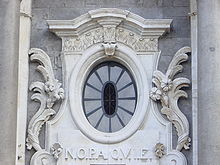Ox eye (architecture)
A bull's-eye ( French oeil-de-boeuf ), also round window or oculus ( lat. For "eye"), is a since the ancient times known, both in the Romanesque and the Gothic resumed window shape , the later mainly in Baroque and Art Nouveau was common: a circular or oval window, which is mostly used decoratively over portals or in the gable area. Even pop-up window are often carried out in this form. Round windows with a stone tracery filling are called rosettes , their Romanesque predecessors with filling in the form of a spoked wheel are called wheel windows .
The circular openings in the domed vaults in bell towers of medieval church buildings, through which the bells could be transported vertically, as well as building materials and equipment for the construction and subsequent maintenance of the tower structures, are also referred to as oculus . Oculi of this kind are also known as dome eyes (see Opaion ). The opening is sometimes bordered decoratively, for example in the form of eight-sided tracery.
The spread is not limited to church architecture . In the late Romanesque, this window shape can be found in the secular architecture of castles of Emperor Frederick II of Hohenstaufen ( Castel del Monte , Palazzo San Gervasio , at the donjon in the fort of Lucera and others), and later also in the palace and villa construction of the Renaissance and of the baroque.
Ox eyes are also found in half-timbered buildings as round or oval window shapes ( dormer windows ).
Speyer Cathedral , oculus in the Romanesque St. Afra Chapel
Oculus window on the nave of the Gothic Basilica of San Petronio in Bologna (1393–1479)
Ox-eye window in the Justinuskirche in Frankfurt - Höchst
Ox eyes on the tower of Rietberg Castle , attached in the 17th century.
Three oculi in the gable area of a semi-detached house in Augsburg
Ox eyes on the north facade of the Trinity Church (Regensburg)






